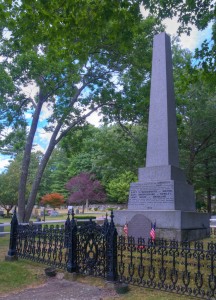.png)
Descendants of Thomas Hawley
Thomas Hawley is commonly believed to be a brother of Joseph Hawley (1603-1690). Given that the year of his birth is an assumption, he could possibly have been a son from a marriage of Joseph’s prior to Katharine Birdsey. We may never know for certain, but DNA evidence from the Family Tree DNA Hawley Surname Project confirms that the descendants of Thomas and Joseph are closely related. Thomas is considered the founder of the Massachusetts branch of the Hawley family.
Thomas Hawley was an early settler of Roxbury, Massachusetts, but just what year has not been ascertained. His first wife was named Emma and she was buried 29 November 1651. Her son, Thomas, was baptized 8 October 1651 and she died not quite two months afterward. He married for the second time 2 February 1652, Dorothy Harbottle, the widow of Thomas Lamb. She was a member of Mr. Eliot’s church and married Mr. Lamb 16 July 1640, by whom she had two sons (Caleb and Joshua) and he died in 1646. Thomas Hawley was killed by Native Americans at the Sudbury Fight 21 April 1676 and Dorothy died 28 January 1699.

The monument reads:
This monument is erected by the Commonwealth of Massachusetts and the town of Sudbury in grateful rememberance of the services and sufferings of the founders of the state: and especially in honor of
Capt. S. Wadsworth of Milton.
Capt Brocklebank of Rowley,
Lieut. Sharp of Brookline.
and twenty six others, men of their command, who fell near this spot on the 18th of April 1676 while defending the frontier settlements against allied Indian forces of Philip of Pokanoket.
1852
This monument replaced an earlier one that was erected on this spot in 1730 by Reverend Benjamin Wadsworth, President of Harvard College in memory of his father and the others killed that day in King Philip’s War.
About 1645, Roxbury town records were destroyed by fire, and in 1652, a committee of five were appointed by the town to make a new record of the lands of the town as they were known to have been surveyed to different parties. In the record made by this committee, Thomas Hawley’s land was not rerecorded, yet he was an owner then and had been for a number of years. In this land record his name is spelled “Halye” and “Hally”, yet this is the same as Rev John Eliot, the pastor of the Roxbury church, uses in one instance when he spells the name two ways in the same entry, in the baptisms as: “Joseph Haly, sonn to Tho. Hawly”. Besides, Thomas Halye’s land was located close to the mill, under the water wheels of which Thomas “Hawly’s” son passed. Excerpted from THE HAWLEY RECORD, pg 437, Note 5
In 1675, the peace of New England was disturbed by King Philip’s war. King Philip, so called by the colonists, was actually Chief Metacoment of the Wampanoag of Massachusetts. The Chief thought the colonists murdered his brother and sought to drive them from New England. There were 60,000 colonists and 36,000 Native Americans. Thomas was in a party of eighteen men under the command of Capt. Samuel Wadsworth, who were attacked about three miles from Sudbury. Ten colonists were killed, including Thomas Hauley. His descendants either adopted the Hawley spelling or perhaps used it all along with the name previously misspelled by a scribe in the colony.


